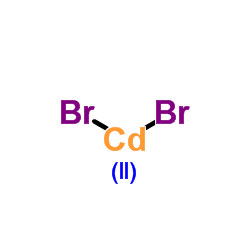cadmium bromide
Modify Date: 2024-01-09 22:32:01

cadmium bromide structure
|
Common Name | cadmium bromide | ||
|---|---|---|---|---|
| CAS Number | 7789-42-6 | Molecular Weight | 272.219 | |
| Density | 5,192 g/cm3 | Boiling Point | 863°C | |
| Molecular Formula | Br2Cd | Melting Point | 567°C | |
| MSDS | N/A | Flash Point | 863°C | |
| Name | cadmium(2+),dibromide |
|---|---|
| Synonym | More Synonyms |
| Density | 5,192 g/cm3 |
|---|---|
| Boiling Point | 863°C |
| Melting Point | 567°C |
| Molecular Formula | Br2Cd |
| Molecular Weight | 272.219 |
| Flash Point | 863°C |
| Exact Mass | 271.740021 |
| Stability | Stable. |
|
Section 1: Product Identification Chemical Name:Cadmium bromide, anhydrous, 99% CAS Registry Number:7789-42-6 Formula:CdBr2 EINECS Number:232-165-1 Chemical Family:metal halide Synonym:Cadmium dibromide
Section 2: Composition and Information on Ingredients IngredientCAS NumberPercentACGIH (TWA)OSHA (PEL) Title Compound7789-42-6100%0.002mg/m30.005mg/m3 Section 3: Hazards Identification Irritating to skin, eyes and respiratory tract. Harmful by inhalation, in contact with skin and if swallowed. May Emergency Overview: cause cancer. Primary Routes of Exposure:Ingestion, inhalation Eye Contact:Causes mild to severe irritant to the eyes. Skin Contact:Causes slight to mild irritation of the skin. irritating to the respiratory tract. Harmful by inhalation. May cause coughing, headache, shortness of breath, Inhalation: chest pains and pulmonary edema. Harmful if swallowed. Ingestion may lead to sudden nausea, vomiting, bloody diarrhea, weakness, Ingestion: convulsions, and death. Harmful by inhalation, in contact with skin and if swallowed. irritating to skin, eyes and respiratory tract. Acute Health Affects: Ihalation may cause metallic taste, cough, chest pain, pulmonary edema, liver and kidney damage. Prolonged exposure may cause loss of sense of smell, weight loss, liver, lung, skeletal and kidney damage. Chronic Health Affects: Cadmium is a recognized carcinogen of the connective tissue, lungs, and the liver. NTP:Yes IARC:Yes OSHA:No SECTION 4: First Aid Measures Immediately flush the eyes with copious amounts of water for at least 10-15 minutes. A victim may need Eye Exposure: assistance in keeping their eye lids open. Get immediate medical attention. Wash the affected area with water. Remove contaminated clothes if necessary. Seek medical assistance if Skin Exposure: irritation persists. Remove the victim to fresh air. Closely monitor the victim for signs of respiratory problems, such as difficulty Inhalation: in breathing, coughing, wheezing, or pain. In such cases seek immediate medical assistance. Seek medical attention immediately. Keep the victim calm. Give the victim water (only if conscious). Induce Ingestion: vomiting only if directed by medical personnel. SECTION 5: Fire Fighting Measures Flash Point:not applicable Autoignition Temperature:none Explosion Limits:none Extinguishing Medium:none required Special Fire Fighting Procedures:No special fire fighting procedures required. Hazardous Combustion andToxic dusts contain cadmium Decomposion Products: Unusual Fire or Explosion Hazards: No unusual fire or explosion hazards. SECTION 6: Accidental Release Measures Spill and Leak Procedures:Small spills can be mixed with vermiculite or sodium carbonate and swept up. SECTION 7: Handling and Storage Handling and Storage:Store material in a tightly sealed container. Will adsorb moisture if handled in a moist environment. SECTION 8: Exposure Controls and Personal Protection Eye Protection:Always wear approved safety glasses when handling a chemical substance in the laboratory. Skin Protection:Wear appropriate chemical resistant gloves and protective clothing. Ventilation:Material may form a fine dust. If possible, handle the material in an efficient fume hood. In the absence of adequate ventilation a respirator should be worn. The use of a respiratory requires a Respirator: Respirator Protection Program to be in compliance with 29 CFR 1910.134. Ventilation:Material may form a fine dust. If possible, handle the material in an efficient fume hood. Additional Protection:No additional protection required. SECTION 9: Physical and Chemical Properties Color and Form:white pwdr. Molecular Weight:272.22 Melting Point:567° Boiling Point:863°C Vapor Pressure:no data Specific Gravity:5.192 Odor:none Solubility in Water: SECTION 10: Stability and Reactivity Stability:hygroscopic Hazardous Polymerization:no hazardous polymerization Conditions to Avoid:contact with moisture Incompatibility:active metals Decomposition Products:none SECTION 11: Toxicological Information RTECS Data:Oral (rat); LD50: 322 mg/kg. Oral (rat); LD50: 733 mg/kg/90D-C. Carcinogenic Effects:Carcinogen (as Cd) Mutagenic Effects:No data available Tetratogenic Effects:No data available SECTION 12: Ecological Information Avoid release into the environment. Very toxic to aquatic organisms. May cause long-term adverse effects in Ecological Information: the aquatic environment. SECTION 13: Disposal Considerations Disposal:Dispose of according to local, state and federal regulations. SECTION 14: Transportation Shipping Name (CFR):Cadmium compounds Hazard Class (CFR):6.1 Additional Hazard Class (CFR):NA Packaging Group (CFR):III UN ID Number (CFR):UN# 2570 Shipping Name (IATA):Cadmium compound Hazard Class (IATA):6.1 Additional Hazard Class (IATA):NA Packaging Group (IATA):III UN ID Number (IATA):UN# 2570 SECTION 15: Regulatory Information TSCA:Listed in the TSCA inventory. SARA (Title 313):Title compound see Category Code N078 for reporting. Second Ingredient:none SECTION 16 - ADDITIONAL INFORMATION N/A |
CHEMICAL IDENTIFICATION
HEALTH HAZARD DATAACUTE TOXICITY DATA
|
| Hazard Codes | Xn,N |
|---|---|
| Risk Phrases | 20/21/22-50/53 |
| Safety Phrases | S60-S61 |
| RIDADR | UN 3077 9/PG 3 |
| WGK Germany | 3 |
| RTECS | EU9935000 |
| Packaging Group | III |
| Hazard Class | 6.1 |
| cadmium(2+) dibromide |
| Cadmiumbromide (8CI) |
| MFCD00015996 |
| EINECS 232-165-1 |
| Cadmium dibromide |